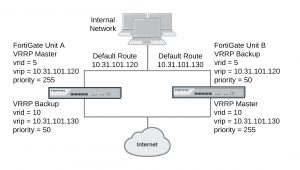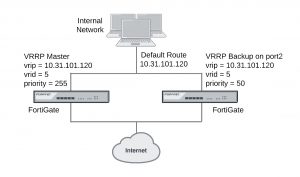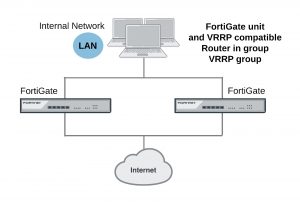FortiGate VM for Hyper-V HA configuration
Promiscuous mode and support for MAC address spoofing is required for FortiGate-VM for Hyper-V to support FortiGate Clustering Protocol (FGCP) high availability (HA). By default the FortiGate-VM for Hyper-V has promiscuous mode enabled in the XML configuration file in the FortiGate-VM Hyper-V image. If you have problems with HA mode, confirm that this is still enabled.
In addition, because the FGCP applies virtual MAC addresses to FortiGate data interfaces and because these virtual MAC addresses mean that matching interfaces of different FortiGate-VM instances will have the same virtual MAC addresses you have to configure Hyper-V to allow MAC spoofing. But you should only enable MAC spoofing for FortiGate-VM data interfaces. You should not enable MAC spoofing for FortiGate HA heartbeat interfaces.
With promiscuous mode enabled and the correct MAC spoofing settings you should be able to configure HA between two or more FortiGate-VM for Hyper-V instances.
Troubleshooting layer-2 switches
Issues may occur because of the way an HA cluster assigns MAC addresses to the primary unit. Two clusters with the same group ID cannot connect to the same switch and cannot be installed on the same network unless they are separated by a router.
Forwarding delay on layer 2 switches
You must ensure that if there is a switch between the FortiGate HA cluster and the network its is protecting and the switch has a forwarding delay (even if spanning tree is disabled) when one of its interfaces is activated then the forwarding delay should be set as low as possible. For example, some versions of Cisco IOS have a forwarding delay of 15 seconds even when spanning tree is disabled. If left at this default value then TCP session pickup can fail because traffic is not forwarded through the switch on HA failover.
Failover issues with layer-3 switches
After a failover, the new primary unit sends gratuitous ARP packets to refresh the MAC forwarding tables of the switches connected to the cluster. If the cluster is connected using layer-2 switches, the MAC forwarding tables (also called arp tables) are refreshed by the gratuitous ARP packets and the switches start directing packets to the new primary unit.
In some configurations that use layer-3 switches, after a failover, the layer-3 switches may not successfully re- direct traffic to the new primary unit. The possible reason for this is that the layer-3 switch might keep a table of IP addresses and interfaces and may not update this table for a relatively long time after the failover (the table is not updated by the gratuitous ARP packets). Until the table is updated, the layer-3 switch keeps forwarding packets to the now failed cluster unit. As a result, traffic stops and the cluster does not function.
As of the release date of this document, Fortinet has not developed a workaround for this problem. One possible solution would be to clear the forwarding table on the layer-3 switch.
The config system ha link-failed-signal command described in Updating MAC forwarding tables when a link failover occurs on page 1531 can be used to resolve link failover issues similar to those described here.
Changing spanning tree protocol settings for some switches
Configuration changes may be required when you are running an active-active HA cluster that is connected to a switch that operates using the spanning tree protocol. For example, the following spanning tree parameters may need to be changed:
Maximum Age The time that a bridge stores the spanning tree bridge control data unit (BPDU) before discarding it. A maximum age of 20 seconds means it may take 20 seconds before the switch changes a port to the listening state.
Forward Delay
The time that a connected port stays in listening and learning state. A forward delay of 15 seconds assumes a maximum network size of seven bridge hops, a maximum of three lost BPDUs and a hello-interval of 2 seconds.
For an active-active HA cluster to be compatible with the spanning tree algorithm, the FGCP requires that the sum of maximum age and forward delay should be less than 20 seconds. The maximum age and forward delay settings are designed to prevent layer 2 loops. If there is no possibility of layer 2 loops in the network, you could reduce the forward delay to the minimum value.
For some Dell 3348 switches the default maximum age is 20 seconds and the default forward delay is 15 seconds. In this configuration the switch cannot work with a FortiGate HA cluster. However, the switch and cluster are compatible if the maximum age is reduced to 10 seconds and the forward delay is reduced to 5 seconds.
Spanning Tree protocol (STP)
Spanning tree protocol is an IEEE 802.1 standard link management protocol that for media access control bridges. STP uses the spanning tree algorithm to provide path redundancy while preventing undesirable loops in a network that are created by multiple active paths between stations. Loops can be created if there are more than route between two hosts. To control path redundancy, STP creates a tree that spans all of the switches in an extended network. Using the information in the tree, the STP can force redundant paths into a standby, or blocked, state. The result is that only one active path is available at a time between any two network devices (preventing looping). Redundant links are used as backups if the initial link should fail. Without spanning tree in place, it is possible that two connections may be simultaneously live, which could result in an endless loop of traffic on the network.
Bridge Protocol Data Unit (BPDU)
BPDUs are spanning tree data messages exchanged across switches within an extended network. BPDU packets contain information on ports, addresses, priorities and costs and ensure that the data ends up where it was intended to go. BPDU messages are exchanged across bridges to detect loops in a network topology. The loops are then removed by shutting down selected bridge interfaces and placing redundant switch ports in a backup, or blocked, state.
Failover and attached network equipment
It normally takes a cluster approximately 6 seconds to complete a failover. However, the actual failover time may depend on how quickly the switches connected to the cluster interfaces accept the cluster MAC address update from the primary unit. If the switches do not recognize and accept the gratuitous ARP packets and update their MAC forwarding table, the failover time will increase.
Also, individual session failover depends on whether the cluster is operating in active-active or active-passive mode, and whether the content of the traffic is to be virus scanned. Depending on application behavior, it may take a TCP session a longer period of time (up to 30 seconds) to recover completely.
Ethertype conflicts with third-party switches
Some third-party network equipment may use packets with Ethertypes that are the same as the ethertypes used for HA heartbeat packets. For example, Cisco N5K/Nexus switches use Ethertype 0x8890 for some functions. When one of these switches receives Ethertype 0x8890 heartbeat packets from an attached cluster unit, the switch generates CRC errors and the packets are not forwarded. As a result, FortiGate units connected with these switches cannot form a cluster.
In some cases, if the heartbeat interfaces are connected and configured so regular traffic flows but heartbeat traffic is not forwarded, you can change the configuration of the switch that connects the HA heartbeat interfaces to allow level2 frames with Ethertypes 0x8890, 0x8893, and 0x8891 to pass.
You can also use the following CLI commands to change the Ethertypes of the HA heartbeat packets:
config system ha
set ha-eth-type <ha_ethertype_4-digit_hex>
set hc-eth-type <hc_ethertype_4-digit_hex>
set l2ep-eth-type <l2ep_ethertype_4-digit_hex>
end
For more information, see Heartbeat packet Ethertypes on page 1504.
LACP, 802.3ad aggregation and third-party switches
If a cluster contains 802.3ad aggregated interfaces you should connect the cluster to switches that support configuring multiple Link Aggregation (LAG) groups.
The primary and subordinate unit interfaces have the same MAC address, so if you cannot configure multiple LAG groups a switch may place all interfaces with the same MAC address into the same LAG group; disrupting the operation of the cluster.
You can change the FortiGate configuration to prevent subordinate units from participating in LACP negotiation. For example, use the following command to do this for an aggregate interface named Port1_Port2:
config system interface edit Port1_Port2
set lacp-ha-slave disable end
This configuration prevents the subordinate unit interfaces from sending or receiving packets. Resulting in the cluster not being able to operate in active-active mode. As well, failover may be slower because after a failover the new primary unit has to perform LACP negotiation before being able to process network traffic.
For more information, see Example: FGCP configuration examples and troubleshooting on page 1354.



